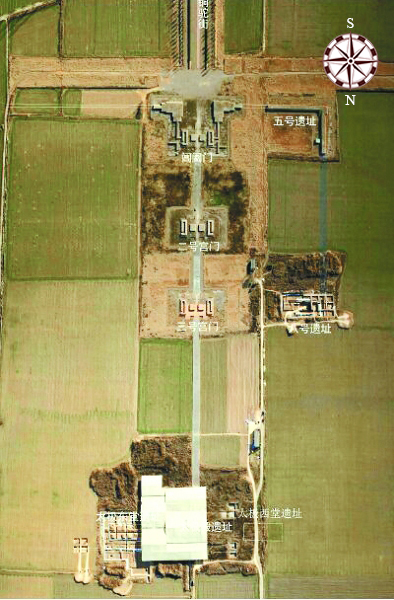Archaeological finds reveal ancient Chinese capitals

Aerial photo which shows the central area of Luoyang City of the Northern Wei (386–534) Photo: ZJPDC
NANJING—Nearly 120 archaeologists exchanged ideas on the latest achievements in the archaeological study of ancient Chinese capital cities at an international symposium at Nanjing University in mid-November.
Beginning with the archaeological excavations of the Ruins of Yin in the 1920s, many ancient cities that were never recorded in detail in ancient literature and some whose records have been lost have been discovered. In recent years, many new achievements have been made in the archaeological work on ancient Chinese capitals, demonstrating clearer developments.
With the palace and the royal tombs at the center, the majestic Liangzhu Ancient City (c. 3300–2300 BCE) is the original model for the triple structure of ancient Chinese capitals, with an imperial city, inner city and outer city. Wang Ningyuan, a research fellow at the Zhejiang Provincial Institute of Cultural Relics and Archaeology, said that archaeological excavations in recent years have shown that the Liangzhu Ancient City covers an area of about three square kilometers, with numerous waterways within.
Studies have shown that the water conservancy facilities, palaces and royal tombs of the city were built about 5,000 years ago, the city walls were built about 4,800 years ago, and the construction of the outer city was relatively late. The planning and design of the entire ancient city was completed with a broad vision and the construction technology is relatively mature.
Qian Guoxiang, a research fellow from the Institute of Archaeology at the Chinese Academy of Social Sciences, talked about the importance of the archaeological excavation of Luoyang City for understanding the Han and Wei period. He said that the excavation of the imperial city and the Taiji Hall of the imperial palace in Luoyang City helped confirm that the Taiji Hall of the Northern Wei (386–534) was restored and reconstructed based on the Taiji Hall that started to be built during the Cao Wei period (220–265).
Archaeological evidence has confirmed, Qian continued, that the single palace with Taiji Hall at its center was placed at the very axis of the whole city to symbolize the supreme power of the central government for the first time in Chinese history. This started a new cultural tradition, impacting profoundly the palace system and capital layout for over a thousand years in later China and East Asia.
The ancient city of Tanjialing, located in the center of the Shijiahe ruins (c. 4000–2000 BCE) in Tianmen, Hubei Province, is estimated to date back to the late period of the Youziling culture (c. 3900–3100 BCE). There are multi-layered ruins such as city walls and artificial moats, showing a development process beginning inside directed outward. Around Tanjialing, there are also ruins of large-scale pottery sites in Sanfangwan and places of worship at Yinxintai.
Composing more than forty sites including Tanjialing, Sanfangwan, Yinxintai, Luojiabailing and Dengjiawan, the Shijiahe site is the largest in area among prehistoric settlement sites that have been discovered in the middle reaches of the Yangtze River so far, and the ancient city it represents was the longest surviving and of the highest level among such other remains, said Liu Hui, a research fellow at the Hubei Provincial Institute of Cultural Relics and Archaeology. The Shijiahe site can be regarded as the center of civilization in the middle reaches of the Yangtze River, playing an important role in cultural leadership and the spread of culture at that time.
So far, the Shimao site is the largest city site that has been discovered of the late Longshan Period (c. 2500–2000 BCE) and the early Xia Dynasty (c. 2070–1600 BCE). Shao Jing, an associate research fellow at the Shaanxi Provincial Institute of Archaeology, said that the site of Shimao City is basically preserved intact, consisting of the Huangchengtai raised platform, the inner city and the outer city. Shimao was the center of the Hetao Area at that time. At the Shimao site, the earliest known and largest collection in the world of plucked idiophones (the reed-organ)were unearthed, along with many cultural relics such as building tiles, eagle-shaped pottery figurines and bronze products.
Scholars said that the archaeological study of capital cities has become one of the most important areas of archaeology. The archaeological research of ancient Chinese capitals is focused on the history of the capitals, the sequence of their construction, and their spatial structure and functions, which is crucial for unveiling the origins of Chinese civilization, for the historical study of the development of Chinese capitals and for the research on the planning and layout of ancient capitals.
(edited by JIANG HONG)
